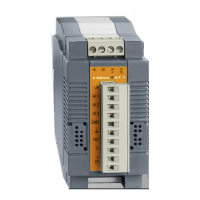e.bloxx A6-2CF
MEASUREMENTS
22
HB_EBLOXX-A62CF_E_V19.doc
Gantner Instruments Test & Measurement GmbH
Analog Input
The analog input is prepared for the connection of the most common bridge transducers (strain gauges, piezo-resistive,
inductive), LVDT, potentiometer transducers as well as single strain gauges. Currently data of a large number of
standardized and proprietary sensors are stored in the e.bloxx A6-2CF. Particularly the following types of bridges can be
connected to the e.bloxx A6-2CF:
- Strain gauge and inductive full bridge
- Strain gauge and inductive half bridge
- Strain gauge quarter bridge (3 lead)
- LVDT
- Piezo-resistive transducer
- Potentiometer transducer
All bridge transducers are build up as Wheatstone bridges (not so LVDT and potentiometer). That allows the stable
measurement of the very small signals. As Wheatstone bridges are passive, the e.bloxx A6-2CF provides a bridge
excitation voltage of +/-5 V
RMS
, 2.5 V
RMS
and +/-1 V
RMS
with a carrier frequency of 4.8 kHz. The advantages of carrier
frequency principle are a higher signal stability, a better signal to noise ratio, a better behavior regarding disturbing
signals and the flexibility to use resistive and inductive transducers.
Depending on the bridge excitation the measuring range can be selected:
Bridge Excitation / Bridge Resistance
±5.0 VRMS / < 350 Ohms ±2.5 VRMS / < 175 Ohms ±1.0 VRMS / < 70 Ohms
Low
scalable Range
2.5 mV/V
0.1 … 2.5 mV/V
5.0 mV/V
0.2 … 5.0 mV/V
12.5 mV/V
0.5 … 12.5 mV/V
Medium
scalable Range
50 mV/V
2 … 50 mV/V
100 mV/V
4 … 100 mV/V
250 mV/V
10 mV/V … 250 mV/V
Measuring Range
High
scalable Range
250 mV/V
10.0 … 250 mV/V
500 mV/V
20.0 … 500 mV/V
1250 mV/V
50.0 … 1250 mV/V
Table 4.1.
- Measuring Ranges for Bridge Measurements
The coarse ranges are in the input circuit by hardware realized gain factors. The selection of a lower measuring range
will be done by calculation in the digital signal processor (DSP). Due to the high ADC resolution of 19 bit (e. g. 2.5 mV/V
= 250000 steps) a signal solution of the selected range e. g. 0.5 mV/V will be 50000. To provide the signal at the analog
output a 16 bit DAC will convert the mentioned 50000 stept in a 10 V Signal. So the e.bloxx A6-2CF could look like a
analog amplifier with a input range of 0.1 to 1250 mV/V. This new method is called “total digitalization” and is usually
used in digital high-end products. Due to this method no internal knobs and potentiometers are required. A further
advantage is the relative low input gain, which is not as sensitive regarding disturbances like products with a high input
gain.
In the Configuration Table of the Configuration Software ICP 100 the coarse ranges are selectable in the "Sensor"-
column. The scaling can be defined in the "Format"-column.

